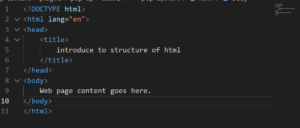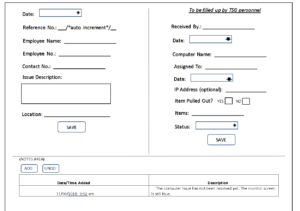Introduction
Html stands for hypertext markup language. We use this language to create Frontend Websites. The first version of HTML was written by Tim Berners-Lee in 1993. It gets updates from time to time. Now its new version is HTML5. HTML5 is the latest major revision of the HTML standard.
- Importance in Web Development
HTML describes the structure of the web page. HTML forms the basis of web content. It contains a set of markup symbols and codes.Html provides Accessibility and all Browsers support html. HTML elements tell the browser how to display the content.
“The role of HTML is to provide the backbone and structure of a web page.”
HTML is a Structural fluidity language, it provides responsive web design (RWD) and encourages the use of fluid grids and flexible elements that can adjust according to the screen size. Let’s review it briefly.
Structure of HTML
Here is the structure of HTML:

-
- The <!DOCTYPE html> tells the version of HTML. Its declaration defines this document as an HTML document. The <html> element is the root element of an HTML page. The root element that wraps the complete HTML record.
- The <head> element contains meta information about the HTML page. The head tag contains the behind the scenes elements for a webpage.
- The <title> element defines what text will show in the web browser’s title bar.
- The <body> element defines the document’s body and is a container for all the visible contents, such as videos, headings, paragraphs, images, tables lists, etc.
HTML Tag
HTML tags are the root of HTML documents.
We discuss mostly used tags in html, Let’s review it briefly.
-
- <div>….</div>: Defines the division or section in an HTML document. This element is by default a block element. The <div> element has no required attributes, but style, Class, and id are common.
- <p>…..</p>: This tag defines the paragraph.
- <a href=””>…</a>: it is called a hyperlink, and it is also called an anchor tag. We use this tag. href=”” is an attribute we use this tag only for a placeholder for a hyperlink.
- <img src=”” alt=”” >: It is used to embed an image. src=”” is an attribute, that specifies the path to the image.
- <ul>…</ul> , <li></li> : ul stands for an unordered list, we use these tags for listing, nav and in table, etc.
- <ol>….</ol>: it is called ordered list, ul and it’s working the same.
- <li>….</li> This tag defines a list item.
- <table>…</table>:This tag defines a table. We use this tag for creating tables.
- <tr>…</tr>: This tag stands for table row.
- <td>…..</td>: This tag defines a table data cell.
- <form>….</form>: This tag defines an HTML form for user input. The form tag is usually used to send a server for processing.
- <input type=”….” >: This tag defines an input control within a form. It specifies an input field where the user can enter data.
- <button>…</button>: This tag defines a clickable button.
- <h1>…</h1>—<h6>..</h6>: This tag define headings of different levels.
- <span>…</span>: This tag defines a generic inline container.
- <label >…</label>: This tag defines a label for an input element.
- <iframe src=”…”>: This tag embeds an inline frame for external content.
Forms and Input
An HTML form is a section of a document that contains controls such as text fields, password fields, checkboxes, radio buttons, submit buttons, menus, listings, tables, nav, etc.
Here is an example of forms and inputs.

Best Practices of HTML
HTML best practices help developers offer innovative and highly interactive websites and web apps. These best practices help you develop the most feature-rich and business-centric applications. Plus, organizations can harness these best practices to provide a seamless user experience.
Conclusion
As we’ve explored, HTML is the backbone of web development, providing the structure and foundation for every webpage you encounter. Whether you’re just starting out or looking to refine your skills, mastering HTML is essential to becoming a proficient web developer.
From understanding the basic tags that define the structure of a webpage to exploring the new elements introduced in HTML5, you’ve gained a solid foundation that will serve you well in your coding journey. Remember, writing clean, semantic, and accessible HTML not only improves the user experience but also enhances your site’s performance and SEO.
Don’t stop here—practice what you’ve learned by building your projects, experimenting with different tags, and continuously refining your code. For further learning, consider diving into CSS and JavaScript, which work hand-in-hand with HTML to create dynamic and visually appealing websites.
Happy coding!